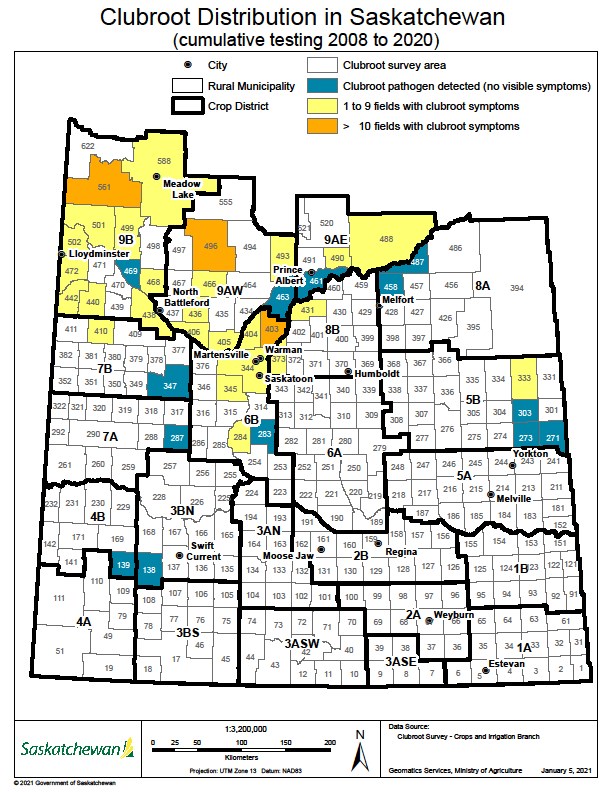Submitted
Jan. 11, the Government of Saskatchewan and SaskCanola released the 2020 Saskatchewan Clubroot Distribution Map, which outlines the rural municipalities (RMs) where clubroot has been identified.
Clubroot is a declared pest under Saskatchewan’s��Pest Control Act. Visible clubroot symptoms have been confirmed in 75 commercial canola fields since 2017.�� This has increased by 24 fields since the last update one year ago.��The number of fields with the clubroot pathogen detected where there were no visible symptoms also increased by 18 in 2020, for a total of 29 fields. These results are compiled annually via ministry surveys and reports/samples submitted to the ministry and SaskCanola by producers and agrologists.��
“Tracking, early detection and management of clubroot will allow producers to prevent substantial yield loss,” Agriculture Minister David Marit said. “Education and awareness of clubroot continue to be a priority to help growers and industry members prevent the further spread of the disease within Saskatchewan.”
Last year, the ministry and SaskCanola offered producers the opportunity to take home soil testing bags to fill and mail in for testing.�� Due to the COVID-19 pandemic, soil testing bags could not be picked up at events such as Ag in Motion, as in previous years. However, producers and agrologists were still able to receive a free soil testing bag via the ministry’s website, or from a regional office, SaskCanola office or their division plant health officer. Distribution of testing bags was aided by the Saskatchewan Association of Rural Municipalities’ participation in the 2020 clubroot monitoring program.�� In all, 231 soil samples were submitted and sent to Discovery Seed Labs, where they were tested for the clubroot pathogen.��Of these soil samples, 11 returned positive results. SaskCanola covered the costs of each test
“Surveying the province for the disease is important to ensure that we are making our decisions about management on evidence and data,” SaskCanola Board of Directors Chair Wayne Truman said.��“We continue to encourage farmers to test their soil for clubroot so that it can be caught early and reduce the potential impact on yield.”
The goal of the tests is to detect the pathogen when spore levels are low to minimize potential impact on canola yields.�� A proactive and science-based clubroot management strategy should include the use of clubroot-resistant canola varieties in a minimum three-year rotation.��An extended crop rotation helps minimize yield losses while protecting the effectiveness of clubroot-resistant canola varieties.
Over 966 fields were examined during the 2020 clubroot monitoring program. The landowners of all fields with visible clubroot symptoms or fields with the presence of the pathogen have been contacted.�� The locations of these fields have also been shared with the appropriate RM office if they had enacted a clubroot-specific bylaw.�� ll clubroot-infested fields will be monitored by an appointed pest control officer.��The specific land locations are not shared publicly to protect the privacy of producers.
��




